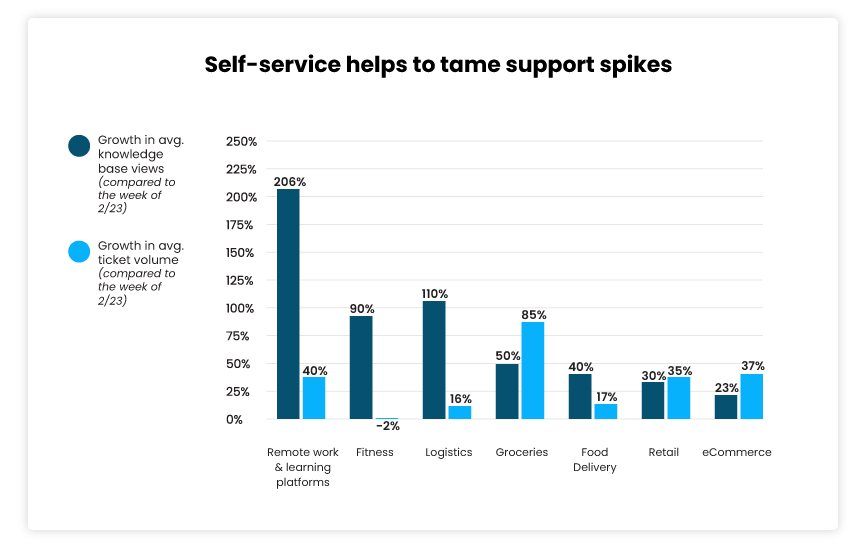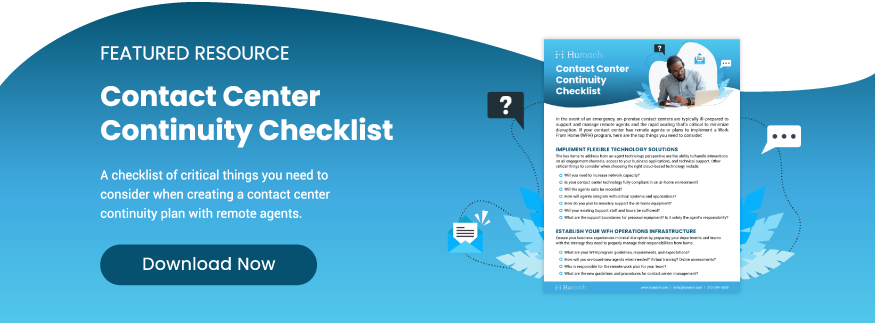While the global health and economic crisis has radically altered businesses across the globe, it’s also given us valuable insight on consumer habits and new adaptive customer experience strategies that are helping minimize the disruption.
In this blog post, we’ve compiled benchmark data, valuable customer insight, a list of new strategies and innovative solutions, and a free Contact Center Continuity Checklist to help you prepare for the future, develop your own adaptive contact center strategy, and get your business back on track.
Key Points
1. Self-service is outperforming ticket growth
2. Agile companies are seeing success with live engagement
3. Newly adopted digital behaviors will continue
4. Remote contact centers are the new “normal”
5. Helpful resources
Self-service is outperforming ticket growth
As high-ticket levels continue to overwhelm teams across the globe, help centers and FAQ areas have become vital resources for customers in need of resolution who are trying to avoid long wait times. Help center views for remote work and learning platforms are up 200% (five times more than the average ticket volume), logistics is up 110% (16% increase in tickets), fitness is also up 90% (2% decrease in tickets), and food delivery is up 40% (17% increase in tickets).
Businesses and industries who have struggled to leverage help centers include grocery delivery, retail, and eCommerce.
Agile companies are seeing success with live engagement
As we all know, long wait and resolutions times lead to low customer satisfaction (CSAT). Companies in the travel industry saw email and web form resolution time increase by 150% since late February, which led to a 4% decrease in customer satisfaction.
However, amid the uncertainty, some businesses have managed to prevent resolution times from rising, even as service requests continue to arrive at record a record high. According to benchmark data, the key is agility—solving tickets more efficiently than competitors on new channels or scaling quickly on existing ones.
According to Zendesk, roughly 3,600 companies have maintained stable resolution times during the crisis by rapidly adding messaging and other live channels to better support their customers. The adoption of messaging jumped an average of 24% since the start of the crisis, with phone and chat adoption also on the rise (up 9%).
These forward-thinking organizations are empowering customers using self-service options like help center articles or helpful resources via AI-powered tools (AI-powered chatbots and Digital Agents are helping solve 10% or more of these requests). By allowing customers to find the answers themselves, 60% have added to their help centers since late February, and 1 in 5 have dedicated additional agent resources to producing new content.
Read Now: What is a Humach Digital Agent?
Newly adopted digital behaviors will continue
As people change their daily routines, even consumers who were previously apprehensive have adopted new online and digital behaviors. A survey of 16 activities found that more than 20% of consumers started using popular video applications like Zoom and Skype to make calls and participate in group discussions with friends and family since the start of the crisis.
So, which activities can we expect to continue? Video calls, live-streaming event attendance, healthcare advice, food and grocery delivery, TV and movie streaming, and online shopping are at the top of the list. According to a recent survey from Qualtrics, online banking has the most momentum with 80% of people reporting they are at least somewhat likely to continue.
Remote contact centers are the new ‘normal’
Before the pandemic, it was hard to imagine how a contact center could ever completely migrate to a work from home model. But, just as customers will continue their adaptive online behaviors, so will the people who support them.
According to Gartner, approximately 90% of global organizations currently use an on-premise solution for their contact centers. The pandemic left these on-premise contact centers ill-prepared to support and manage remote agents and the rapid scaling necessitated by the COVID-19 outbreak. However, for agile businesses, fully-remote service and support became a reality—and a successful one at that. Companies like USAA and T-Mobile are two organizations who saw the benefits of remote agents prior to the pandemic and have seen great success with nearly 100 percent of their workforce running remotely.
Businesses still apprehensive about the transition are struggling with the idea that remote contact centers will continue once the pandemic is over. However, research shows that remote contact centers were always going to be the future of service and support; the pandemic has only accelerated the decision to embrace it for both businesses and customers.
In a 2019 report by IDC and Genesys, of the companies that shifted their on-premise contact operations to the cloud, 72% noted improved customer service, 70% saw improved agent efficiency and productivity, and 71% reported improved scalability. Furthermore, a study from Vonage last year showed that 25% of customers preferred to have their queries handled by a chatbot or other self-service alternative for faster resolutions—and that was before the pandemic disruption.
While 2020 has upended the collective sense of normalcy and put the problems of on-premise contact centers on public display, it’s highlighted the value of agile, AI-augmented cloud-based contact centers. When expertly applied, AI offers a significant competitive advantage in handling customer resolutions with unlimited capacity that doesn’t compromise service quality. Remote contact center models equip organizations with the most valuable attribute in business—the ability to adapt, scale, and adjust in real-time. The cost and operational benefits of remote contact centers are endless, and customers are adapting their behaviors to utilize them, but increased flexibility is the reason they are here to stay.
Helpful Resources
The events of 2020 have created new challenges for companies and their customer experience strategies, making it incredibly difficult to keep up with the aspects that matter most to business—customers and teams. To alleviate some of the pressure, we’ve increased our support resources and our team of experts are available to help work through your pain points, make suggestions, and offer advice to businesses trying to adapt to more cost-effective remote sales and support strategy.
“Our primary focus is helping people acclimate to working remote and minimize disruptions to businesses and their customers,” said Tim Houlne, Humach CEO. “Access to fast and helpful resolutions is more important and means more now than ever before.”
Originally published Jul 9, 2020, updated on Mar 22, 2021






